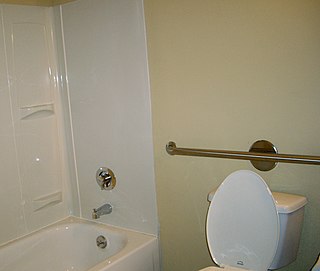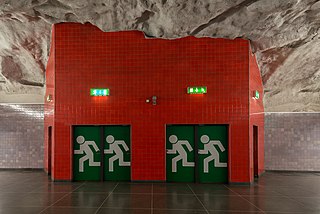
Assistive technology (AT) is a term for assistive, adaptive, and rehabilitative devices for people with disabilities and the elderly. Disabled people often have difficulty performing activities of daily living (ADLs) independently, or even with assistance. ADLs are self-care activities that include toileting, mobility (ambulation), eating, bathing, dressing, grooming, and personal device care. Assistive technology can ameliorate the effects of disabilities that limit the ability to perform ADLs. Assistive technology promotes greater independence by enabling people to perform tasks they were formerly unable to accomplish, or had great difficulty accomplishing, by providing enhancements to, or changing methods of interacting with, the technology needed to accomplish such tasks. For example, wheelchairs provide independent mobility for those who cannot walk, while assistive eating devices can enable people who cannot feed themselves to do so. Due to assistive technology, disabled people have an opportunity of a more positive and easygoing lifestyle, with an increase in "social participation", "security and control", and a greater chance to "reduce institutional costs without significantly increasing household expenses." In schools, assistive technology can be critical in allowing students with disabilities to access the general education curriculum. Students who experience challenges writing or keyboarding, for example, can use voice recognition software instead. Assistive technologies assist people who are recovering from strokes and people who have sustained injuries that affect their daily tasks.

The Americans with Disabilities Act of 1990 or ADA is a civil rights law that prohibits discrimination based on disability. It affords similar protections against discrimination to Americans with disabilities as the Civil Rights Act of 1964, which made discrimination based on race, religion, sex, national origin, and other characteristics illegal, and later sexual orientation and gender identity. In addition, unlike the Civil Rights Act, the ADA also requires covered employers to provide reasonable accommodations to employees with disabilities, and imposes accessibility requirements on public accommodations.

Braille is a tactile writing system used by people who are visually impaired. It can be read either on embossed paper or by using refreshable braille displays that connect to computers and smartphone devices. Braille can be written using a slate and stylus, a braille writer, an electronic braille notetaker or with the use of a computer connected to a braille embosser.

A curb cut (U.S.), curb ramp, depressed curb,dropped kerb (UK), pram ramp, or kerb ramp (Australia) is a solid ramp graded down from the top surface of a sidewalk to the surface of an adjoining street. It is designed primarily for pedestrian usage and commonly found in urban areas where pedestrian activity is expected. In comparison with a conventional curb a curb cut is finished at an intermediate gradient that connects both surfaces, sometimes with tactile paving.

Accessibility is the design of products, devices, services, vehicles, or environments so as to be usable by people with disabilities. The concept of accessible design and practice of accessible development ensures both "direct access" and "indirect access" meaning compatibility with a person's assistive technology.

Computer accessibility refers to the accessibility of a computer system to all people, regardless of disability type or severity of impairment. The term accessibility is most often used in reference to specialized hardware or software, or a combination of both, designed to enable the use of a computer by a person with a disability or impairment.
The DOT pictograms are a set of fifty pictograms used to convey information useful to travelers without using words. Such images are often used in airports, train stations, hotels, and other public places for foreign tourists, as well as being easier to identify than strings of text. Among these pictograms are graphics representing toilets and telephones. As a result of their near-universal acceptance, some describe them as the "Helvetica" of pictograms, and the character portrayed within them as Helvetica Man.
Universal design is the design of buildings, products or environments to make them accessible to people, regardless of age, disability or other factors. It addresses common barriers to participation by creating things that can be used by the maximum number of people possible. Curb cuts or sidewalk ramps, which are essential for people in wheelchairs but also used by all, are a common example of universal design.
Web accessibility, or eAccessibility, is the inclusive practice of ensuring there are no barriers that prevent interaction with, or access to, websites on the World Wide Web by people with physical disabilities, situational disabilities, and socio-economic restrictions on bandwidth and speed. When sites are correctly designed, developed and edited, more users have equal access to information and functionality.

A wheelchair ramp is an inclined plane installed in addition to or instead of stairs. Ramps permit wheelchair users, as well as people pushing strollers, carts, or other wheeled objects, to more easily access a building, or navigate between areas of different height. Ramps for accessibility may predate the wheelchair and are found in ancient Greece.

The Canadian currency tactile feature is a feature on the Canadian Journey and Frontier series of Canadian banknotes to aid people who are visually impaired to identify the notes. The feature indicates the banknote denomination in the upper left corner of the face side of the bill using a series of raised dots. It was suggested by Bruno Thériault, an administrator for the Canadian National Institute for the Blind, and designed by Susan Lederman, a professor of psychology at Queen's University.

ISO 7001 is a standard published by the International Organization for Standardization that defines a set of pictograms and symbols for public information. The latest version, ISO 7001:2023, was published in February 2023.

Tactile paving is a system of textured ground surface indicators found at roadsides, by and on stairs, and on railway station platforms, to assist pedestrians who are vision impaired.

Grab bars are safety devices designed to enable a person to maintain balance, lessen fatigue while standing, hold some of their weight while maneuvering, or have something to grab onto in case of a slip or fall. A caregiver may use a grab bar to assist with transferring a patient from one place to another. A worker may use a grab bar to hold on to as he or she climbs, or in case of a fall.

Accessible toilets are toilets that have been specially designed to better accommodate people with physical disabilities. Persons with reduced mobility find them useful, as do those with weak legs, as a higher toilet bowl makes it easier for them to stand up. Additional measures that can be taken to add accessibility to a toilet include providing more space, adding grab bars to ease transfer to and from the toilet seat, and providing extra room for a caregiver if necessary. Some countries have requirements concerning the accessibility of public toilets. Toilets in private homes can be modified (retrofitted) to increase accessibility.

Accessible tourism is the ongoing endeavor to ensure tourist destinations, products, and services are accessible to all people, regardless of their physical or intellectual limitations, disabilities or age. It encompasses publicly and privately owned and operated tourist locations. The goal of accessible tourism is to create inclusivity of all including those traveling with children, people with disabilities, as well as seniors. This allows those with access requirements to be able to function as an independent using products following the universal design principle, a variety of services, and different environments.

In architecture, light reflectance value (LRV), is a measure of visible and usable light that is reflected from a surface when illuminated by a light source. The measurement is most commonly used by design professionals, such as architectural color consultants, architects, environmental graphic designers and interior designers.

The International Symbol of Access (ISA), also known as the (International) Wheelchair Symbol, denotes areas where access has been improved, mostly for those with disabilities. It consists of a usually blue square overlaid in white with a stylized image of a person in a wheelchair. It is maintained as an international standard, ISO 7001 image of the International Commission on Technology and Accessibility (ICTA), a committee of Rehabilitation International (RI).

An exit sign is a pictogram or short text in a public facility denoting the location of the closest emergency exit to be used in case of fire or other emergency that requires rapid evacuation. Most relevant codes require exit signs to be permanently lit at all times.

In the United States, reserved spaces are mandated by the Americans with Disabilities Act Accessibility Guidelines.
















